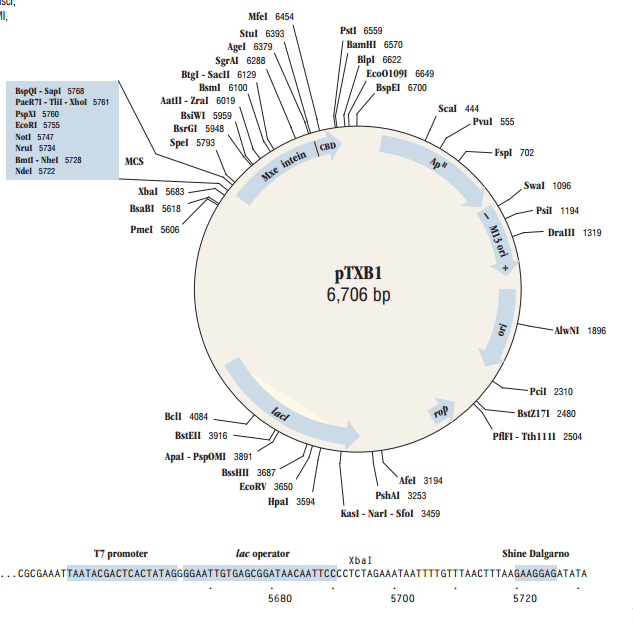pTXB1 载体
| 质粒类型: | 大肠杆菌表达载体 |
|---|---|
| 克隆方法: | 多克隆位点,限制性内切酶 |
| 载体大小: | 6706 bp (查看载体序列) |
| 5' 测序引物及序列: | T7 Fwd |
| 载体标签: | intein |
| 载体抗性: | Ampicillin (氨苄青霉素) |
pTXB1 is an E. coli expression vector in the IMPACT™ Kit (NEB #E6901) (1,2). It is designed for the in-frame insertion of a target gene into the polylinker upstream of the Mxe intein/chitin binding domain (27 kDa) (2,3,4,5). The fusion protein is bound to chitin beads and the thiol-induced cleavage activity of the intein releases the target protein. pTXB vectors are recommended for use in intein-mediated protein ligation and C-terminal labeling (2). This double stranded vector is 6,706 base pairs in length.
Features
- The NdeI site in the polylinker contains an ATG sequence for translation initiation. Unique sites are indicated in bold. SalI site is not unique.
- The SapI site should be used for cloning of the 3´ end of the insert. Use of the SapI site allows cloning of the target protein adjacent to the intein, resulting in cleavage of the target protein without any additional amino acids at its C-terminus.
- Expression of the fusion gene is under the control of an IPTG-inducible T7 promoter (6).
- A pBR322 derivative with a ColE1replication origin.
- Origin of DNA replication from bacteriophage M13, which allows for the production of single-stranded DNA by helper phage superinfection of cells bearing the plasmid (M13K07 helper phage, NEB #N0315).
- Ampicillin resistance.
- Other IMPACT vectors are available which allow for fusion of a target gene to N- or C- terminus of an intein. The cleavage reaction may be induced by thiol reagent or temperature/pH shift.
- Companion vector pTXB3 (NEB #N6708) contains an NcoI site in place of NdeI.
- A wide range of E. coli host strains: T7 Express Competent E. coli (High Efficiency) (NEB #C2566) or BL21(DE3) Competent E. coli (NEB #C2527) and derivatives.



